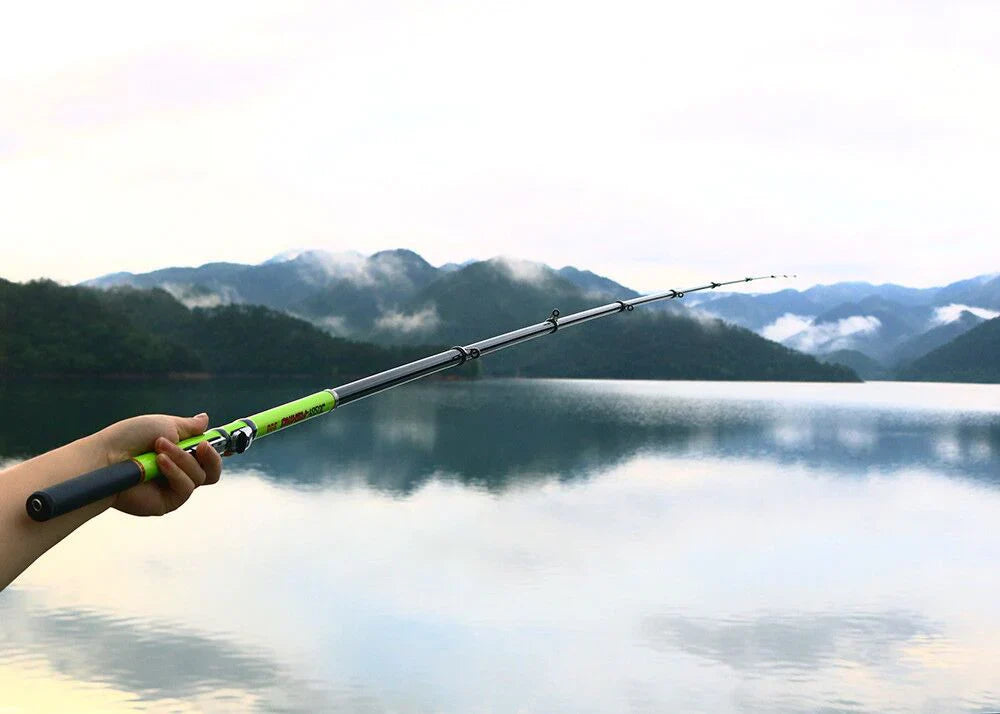

Demystifying rod power, action, and length. Our simple guide will help you choose the perfect spinning rod for your fishing style. Choosing your first fishing rod can be confusing. You see terms like "Medium Power" and "Fast Action," but what do they mean? How do you choose a fishing rod that's right for you? A fishing rod is more than just a stick; it's a precision tool. Understanding its key characteristics is the secret to making a great choice. This guide will crack the code. We will simply explain power, action, and length. You will learn how these factors impact your fishing. Let's find the perfect for your adventures.

Decoding Fishing Rod Power: The Rod's Backbone
Think of a rod's power as its strength or lifting ability. It describes how much pressure it takes to bend the rod. Power ratings range from ultralight to extra heavy. Choosing the correct power is crucial.
What is Rod Power? (From Ultralight to Heavy)
Rod power is usually printed on the rod itself. Here’s a quick breakdown:
-
Ultralight (UL): For very light lines and lures, targeting small fish like panfish.
-
Light (L): Great for trout, panfish, and small bass.
-
Medium (M): The most versatile power, excellent for a wide range of species like bass and walleye. A great choice for a .

-
Medium-Heavy (MH): Offers more backbone for larger lures and bigger fish.
-
Heavy (H): For big fish like catfish, musky, or saltwater species.
How Power Affects Lure Weight and Line Strength
Each rod has a recommended lure weight and line strength. For example, a medium power rod might be rated for 1/4 to 5/8 oz lures and 6-12 lb line. Using a lure that's too heavy can break the rod. Using one that's too light makes casting difficult. Adhering to these ratings ensures optimal performance.
Matching Power to Your Target Fish
What kind of fish do you want to catch? Match the rod power to your target. You wouldn't use an ultralight rod to fight a giant catfish. Likewise, a heavy power rod would take all the fun out of catching a small panfish. The right power provides the best fight and control.
Understanding Fishing Rod Action: How the Rod Bends
A rod's action describes where it bends along its length when pressure is applied. This is different from power. Action determines how quickly the rod tip returns to a straight position. This affects casting, sensitivity, and hook sets.
Fast vs. Moderate vs. Slow Action Explained
Where does your rod bend?
-
Fast Action: Bends mostly in the top third of the rod. It is very sensitive and allows for powerful hook sets.
-
Moderate Action: Bends into the top half of the rod. It's more forgiving and casts moving baits like crankbaits very well.

-
Slow Action: Bends almost all the way to the rod handle. This provides excellent shock absorption for fighting strong fish on light lines.
The Link Between Action, Sensitivity, and Casting Distance
Fast action rods transmit vibrations directly to your hand. This gives them excellent sensitivity to feel bites. However, a moderate action rod will often provide better casting distance. It loads up more energy during the cast. You must choose the action that best suits your needs.
Choosing the Right Action for Your Lures
How do you pick the right action? Match it to your lures. A fast action rod is perfect for single-hook lures like jigs and soft plastics. It provides the power needed for a solid hook set. A moderate action is better for lures with treble hooks, like crankbaits. The slower bend prevents the hooks from tearing out.
Choosing the Right Rod Length: Your Casting Lever
Rod length is another critical decision. The length of the rod acts as a lever for casting. It also affects accuracy and leverage over a fish.
Short Rods (Under 6'6"): Precision and Control
Shorter rods offer excellent accuracy for close-quarters casting. They are great for fishing in tight spaces, like small streams or from a kayak. They give you precise control over your lure placement.
All-Purpose Rods (6'6" to 7'6"): The Sweet Spot
Rods in this length range are the most versatile. A 7-foot rod is a fantastic all-around choice for bank fishing or boat fishing. It offers a great balance of casting distance and accuracy. This makes it a perfect starting point for most anglers.
Long Rods (Over 7'6"): Maximum Casting Distance
Longer rods can cast lures a very long way. They are ideal for covering large areas of open water or for surf fishing. The extra length provides more leverage for long, sweeping hook sets. This is why having the right for each situation is important.
A Quick Word on Rod Materials: Graphite vs. Fiberglass
What is your rod made of? The material significantly impacts performance. Graphite and fiberglass are the two most common materials.
Graphite: The Lightweight and Sensitive Choice
Graphite rods are lightweight, stiff, and very sensitive. They are the most popular choice for modern lure fishing. The sensitivity allows you to feel even the slightest bites. Many excellent options, like the portable , are made from high-quality carbon fiber graphite.
Fiberglass: The Durable and Forgiving Option
Fiberglass rods are extremely durable and flexible. They are heavier than graphite but very forgiving. Their moderate to slow action makes them perfect for crankbaits and other reaction lures. They are also a great, tough choice for kids.
Our Recommendation: The Perfect First Spinning Rod
So, what is the best first spinning rod? For a beginner looking for maximum versatility, we recommend this setup:
-
Length: 6'6" to 7'0"
-
Power: Medium
-
Action: Fast
This combination allows you to fish a wide variety of lures effectively. It works for many common freshwater species. It is the perfect foundation to build your skills upon.
Frequently Asked Questions (FAQ) about Choosing a Fishing Rod
What is the best all-around spinning rod for a beginner?
A 7-foot, medium power, fast action spinning rod is the best all-around choice for a beginner. This setup is incredibly versatile. It lets you fish everything from soft plastics to crankbaits effectively for common species like bass and walleye.
Does rod action affect hook sets?
Yes, significantly. A fast action rod has a stiff backbone that allows for a quick, powerful hook set. This is ideal for single-hook lures. A moderate or slow action rod is more forgiving and helps prevent tearing out treble hooks on lures like crankbaits.
Can I use one fishing rod for all types of fishing?
While one versatile rod can cover many situations, no single rod can do everything perfectly. A medium power rod is a great start, but as you specialize in different techniques (like ultralight fishing or heavy catfishing), you will want to add more specialized to your collection.
What's the difference between a spinning rod and a casting rod?
The main difference is the reel placement and the line guides. A spinning rod has its reel on the underside, with large line guides to reduce friction. A casting rod has the reel on top, with smaller, more numerous guides. They are designed for different types of .











